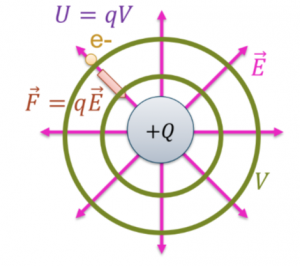17 Unit III On-a-Page

Instructor’s Note
This chapter very strongly follows the ideas of a few distinct discussed in Unit I On-a-Page.
Note, the video below says Unit IV, but the content is correct for Unit III (there used to be a unit between this and the one on optics that I dropped!).

- All charges generate electric fields
 (units N/C orV/m)
(units N/C orV/m) - For a point charge

- Point away from positive, toward negative
- These are real and exist regardless of whether something is there to feel or not!
- Put a charge in an electric field ⇒ it will feel a force

- Can also think in terms of energy: All charges generate electric potentials
 (units Volts)
(units Volts) - For a point charge

- Exists if something is there to feel or not!
- Put a charge in a potential, it has a potential energy

- Electric potentials and electric fields are two sides of the same coin
- Just like in P131: Can think of forces or energy
 points ‘down the potential hill’
points ‘down the potential hill’
A fundamental relationship that describes how the Universe works. These are the fundamental truths of Nature. When writing a principle as an equation, the "=" is translated as "causes." For example, Newton's 2nd Law, F = ma, a force F causes an object m to accelerate (change its speed or direction) a. These principles are where we begin our analyses.

